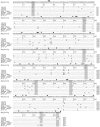Phylogenetic characterization of canine distemper viruses detected in naturally infected dogs in North America
- PMID: 16207955
- PMCID: PMC1248462
- DOI: 10.1128/JCM.43.10.5009-5017.2005
Phylogenetic characterization of canine distemper viruses detected in naturally infected dogs in North America
Abstract
In 2004, six puppies and one adult dog from a total of four premises were subjected to necropsy evaluation. For five of the seven dogs, disease caused by canine distemper virus (CDV) infection was suspected based on clinical signs. In all of the dogs, a diagnosis of CDV infection was established by the presence of compatible gross and histologic lesions, immunohistochemical labeling for CDV antigen, and detection of CDV RNA by reverse transcription-PCR. To further characterize the CDV strains detected in the four cases, complete gene sequences were determined for the hemagglutinin (H) and fusion (F) protein genes, while partial gene sequencing was performed for the phosphoprotein gene. A total of 4,508 bases were sequenced for the CDV strains detected from each of the four cases. Two cases were found to have identical sequences except for 2 bases in the intergenic region of the F and H genes. Phylogenetic analysis strongly suggested an evolutionary relationship between sequences detected in these two cases and those of phocine distemper virus 2 and two other strains of CDV not previously detected in the continental United States. Clear phylogenetic relationships were not established for viruses detected in the two additional cases; however, one strain showed similarity to CDV strains detected in a panda from China. Importantly, the three CDV strains detected were demonstrated to be genetically distinct from known vaccine strains and strains previously reported in the continental United States.
Figures




Similar articles
-
Sequencing of emerging canine distemper virus strain reveals new distinct genetic lineage in the United States associated with disease in wildlife and domestic canine populations.Virol J. 2015 Dec 18;12:219. doi: 10.1186/s12985-015-0445-7. Virol J. 2015. PMID: 26683832 Free PMC article.
-
Effective primary isolation of wild-type canine distemper virus in MDCK, MV1 Lu and Vero cells without nucleotide sequence changes within the entire haemagglutinin protein gene and in subgenomic sections of the fusion and phospho protein genes.J Virol Methods. 2004 Jun 15;118(2):147-57. doi: 10.1016/j.jviromet.2004.02.004. J Virol Methods. 2004. PMID: 15081610
-
Phylogenetic analysis of the wild-type strains of canine distemper virus circulating in the United States.Virol J. 2018 Aug 2;15(1):118. doi: 10.1186/s12985-018-1027-2. Virol J. 2018. PMID: 30068352 Free PMC article.
-
Biological properties of phocine distemper virus and canine distemper virus.APMIS Suppl. 1993;36:1-51. APMIS Suppl. 1993. PMID: 8268007 Review.
-
Evolution and Interspecies Transmission of Canine Distemper Virus-An Outlook of the Diverse Evolutionary Landscapes of a Multi-Host Virus.Viruses. 2019 Jun 26;11(7):582. doi: 10.3390/v11070582. Viruses. 2019. PMID: 31247987 Free PMC article. Review.
Cited by
-
Infection of eight mesocarnivores in New Hampshire and Vermont with a distinct clade of canine distemper virus in 2016-2017.J Vet Diagn Invest. 2019 Jul;31(4):562-567. doi: 10.1177/1040638719847510. Epub 2019 Apr 25. J Vet Diagn Invest. 2019. PMID: 31023162 Free PMC article.
-
Identification of a new genotype of canine distemper virus circulating in America.Vet Res Commun. 2011 Aug;35(6):381-90. doi: 10.1007/s11259-011-9486-6. Epub 2011 Jun 29. Vet Res Commun. 2011. PMID: 21713437
-
Phylodynamic analysis of the canine distemper virus hemagglutinin gene.BMC Vet Res. 2015 Jul 25;11:164. doi: 10.1186/s12917-015-0491-9. BMC Vet Res. 2015. PMID: 26205391 Free PMC article.
-
Canine distemper virus: an emerging disease in wild endangered Amur tigers (Panthera tigris altaica).mBio. 2013 Aug 13;4(4):e00410-13. doi: 10.1128/mBio.00410-13. mBio. 2013. PMID: 23943758 Free PMC article.
-
Canine distemper virus strains circulating among North American dogs.Clin Vaccine Immunol. 2008 Apr;15(4):707-12. doi: 10.1128/CVI.00005-08. Epub 2008 Feb 6. Clin Vaccine Immunol. 2008. PMID: 18256210 Free PMC article.
References
-
- Appel, M. 1987. Canine distemper virus, p. 133-159. In M. J. G. Appel (ed.), Virus infections of carnivores. Elsevier Science Publishers, Amsterdam, The Netherlands.
-
- Appel, M. J., R. A. Yates, G. L. Foley, J. J. Bernstein, S. Santinelli, L. H. Spelman, L. D. Miller, L. H. Arp, M. Anderson, M. Barr, S. Pearce-Kelling, and B. A. Summers. 1994. Canine distemper epizootic in lions, tigers, and leopards in North America. J. Vet. Diagn. Investig. 6:277-288. - PubMed
-
- Appel, M. J., and B. A. Summers. 1995. Pathogenicity of morbilliviruses for terrestrial carnivores. Vet. Microbiol. 44:187-191. - PubMed
-
- Appel, M. J. G. 1978. Reversion to virulence of attenuated canine distemper virus in vivo and in vitro. J. Gen. Virol. 41:385-393.
Publication types
MeSH terms
Substances
Grants and funding
LinkOut - more resources
Full Text Sources
Other Literature Sources

